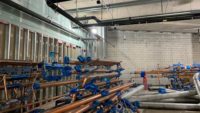Self-assurance around knowing systems are properly installed and operating correctly is a very good thing to have in the construction industry today. Mitigating risk, shrinking the job and certainty of outcome are things we talk about as it relates to execution with our project teams. I respect and appreciate the pure talent and desire our teams possess in delivering projects that include high-end finishes, lots of square footage, more complex systems and integration of those systems.
Systems commissioning is becoming more and more ingrained as it relates to turnover requirements for projects. Large and small, every project benefits from some level of functional testing and commissioning to know that the mechanical and electrical systems are properly installed, operating correctly and utilizing energy resources efficiently. When we know things are working as they were designed and intended, we have that self-assurance.
Not all commercial projects include a commissioning scope (a specification), but that is changing rapidly and there’s also a real need. Whether you’re a design engineer, trade partner or in construction operations, it’s time to realize and embrace the importance of proper energization, startup, testing and turnover of systems. The latest versions of the International Energy Code (2018 IECC and newer) mandate mechanical and electrical (lighting controls) systems perform as designed through commissioning (IECC Section C408).
Commissioning by definition is a systematic process to verify and document that systems have been designed, installed and function properly and can be properly maintained over the service life of the equipment. The testing and commissioning plan must be developed by a registered design professional or an approved agency, and these teams will validate the completed work complies with design documents. The commissioning process typically includes major components for electrical power systems, HVAC equipment, controls, economizer function, central heating and hot water systems. Prior to final mechanical and plumbing inspections, the registered design professional or approved agency shall provide evidence of mechanical systems commissioning and completion in accordance with the IECC (Section C408.2).
Exceptions to commissioning are listed in the IECC for commercial buildings where the total mechanical equipment capacity is less than 480,000 Btu/h cooling capacity (40 tons) and 600,000 Btu/h combined service water-heating and space-heating capacity. Dwelling units and sleeping units have exemptions, however, dwelling units (i.e. apartments) in buildings more than three stories in height are considered commercial buildings and the system testing requirements in the IECC applies (this includes most of the larger residential high-rise projects).
A commissioning plan should include at a minimum:
- A narrative description of the activities that will be accomplished during each phase of commissioning, including the personnel intended to accomplish each of the activities;
- A listing of the specific equipment, appliances or systems to be tested and a description of the testing to be performed;
- Functions to be tested including, but not limited to, calibrations and economizer controls;
- Conditions under which the test will be performed. Testing shall affirm summer and winter design conditions and full economizer conditions; and
- Measurable criteria for performance.
A leading part of the commissioning effort is regular site visits to inspect the work as it’s installed. I like to get time entered in our project schedules where the Cx team is expected or wants to be on site. This helps our construction team be more prepared and also aligns with the number of site visits the Cx team has budgeted. The mechanical and electrical engineers supporting our projects review the same installation features as Cx teams do, and they appreciate the additional assurance that systems are being installed correctly.
Large and small, every project benefits from some level of functional testing and commissioning to know that the mechanical and electrical systems are properly installed, operating correctly and utilizing energy resources efficiently. When we know things are working as they were designed and intended, we have that self-assurance.
Controls installations and HVAC controls being fully functional are critical steps in the testing and commissioning process. Only then can an effective test, adjust and balance effort begin. Test and balance adjustments will include air and water flows, and final flow rates must be within the tolerances listed in the specifications. Equipment performance testing demonstrates the operation of components, systems and system-to-system networking such as building automatic (controls) and fire alarm. I’ve found this low voltage system integration to routinely be a gap where more engineering and coordination is required to bring things together. If you’re not looking at these systems and reviewing shop drawings and contractor engineering early in the project, you won’t realize there are scope gaps or integration problems until late in the project (this topic could be a topic on its own). Equipment testing should include:
- All modes of operation listed in the sequences of operation;
- Redundant or automatic backup modes of operation;
- Performance of alarms (alarms should be evaluated, soft alarms that are notification alarms v. hard alarms that completely shut down the system); and
- Mode of operation upon a loss of power and restoration of power
A preliminary commissioning report should be published and made available with systems separately identified for clarify. We usually see Issues Logs or some reporting on behalf of the Cx team in their tracking system. The Commissioning Compliance Checklist (IECC Figure C408.2.4) is a good tool to ensure proper alignment with construction and commissioning teams.
In the words of Ted Lasso, “There are two buttons I don’t like to push — snooze and panic.” I couldn’t agree more when it comes to commissioning. The commissioning process starts in the design phase and ensures we have fully operable and energy efficient systems working as they should at the end of the project. Who doesn’t want that along with fewer warranty calls?
I hope my last column of 2023 helps you look ahead to the new year thinking about how to design, build and support your projects and project teams more effectively. I want to thank the entire team at JE Dunn Construction who are incredible builders and professionals that are centered on our people and building amazing projects for our clients.




